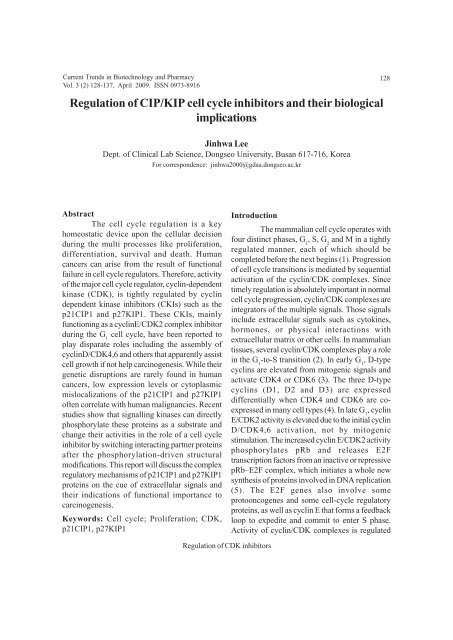April Journal-2009.p65 - Association of Biotechnology and Pharmacy
April Journal-2009.p65 - Association of Biotechnology and Pharmacy
April Journal-2009.p65 - Association of Biotechnology and Pharmacy
Create successful ePaper yourself
Turn your PDF publications into a flip-book with our unique Google optimized e-Paper software.
Current Trends in <strong>Biotechnology</strong> <strong>and</strong> <strong>Pharmacy</strong><br />
Vol. 3 (2) 128-137, <strong>April</strong> 2009. ISSN 0973-8916<br />
Regulation <strong>of</strong> CIP/KIP cell cycle inhibitors <strong>and</strong> their biological<br />
implications<br />
128<br />
Jinhwa Lee<br />
Dept. <strong>of</strong> Clinical Lab Science, Dongseo University, Busan 617-716, Korea<br />
For correspondence: jinhwa2000@gdsu.dongseo.ac.kr<br />
Abstract<br />
The cell cycle regulation is a key<br />
homeostatic device upon the cellular decision<br />
during the multi processes like proliferation,<br />
differentiation, survival <strong>and</strong> death. Human<br />
cancers can arise from the result <strong>of</strong> functional<br />
failure in cell cycle regulators. Therefore, activity<br />
<strong>of</strong> the major cell cycle regulator, cyclin-dependent<br />
kinase (CDK), is tightly regulated by cyclin<br />
dependent kinase inhibitors (CKIs) such as the<br />
p21CIP1 <strong>and</strong> p27KIP1. These CKIs, mainly<br />
functioning as a cyclinE/CDK2 complex inhibitor<br />
during the G 1<br />
cell cycle, have been reported to<br />
play disparate roles including the assembly <strong>of</strong><br />
cyclinD/CDK4,6 <strong>and</strong> others that apparently assist<br />
cell growth if not help carcinogenesis. While their<br />
genetic disruptions are rarely found in human<br />
cancers, low expression levels or cytoplasmic<br />
mislocalizations <strong>of</strong> the p21CIP1 <strong>and</strong> p27KIP1<br />
<strong>of</strong>ten correlate with human malignancies. Recent<br />
studies show that signalling kinases can directly<br />
phosphorylate these proteins as a substrate <strong>and</strong><br />
change their activities in the role <strong>of</strong> a cell cycle<br />
inhibitor by switching interacting partner proteins<br />
after the phosphorylation-driven structural<br />
modifications. This report will discuss the complex<br />
regulatory mechanisms <strong>of</strong> p21CIP1 <strong>and</strong> p27KIP1<br />
proteins on the cue <strong>of</strong> extracellular signals <strong>and</strong><br />
their indications <strong>of</strong> functional importance to<br />
carcinogenesis.<br />
Keywords: Cell cycle; Proliferation; CDK,<br />
p21CIP1, p27KIP1<br />
Introduction<br />
The mammalian cell cycle operates with<br />
four distinct phases, G 1<br />
, S, G 2<br />
<strong>and</strong> M in a tightly<br />
regulated manner, each <strong>of</strong> which should be<br />
completed before the next begins (1). Progression<br />
<strong>of</strong> cell cycle transitions is mediated by sequential<br />
activation <strong>of</strong> the cyclin/CDK complexes. Since<br />
timely regulation is absolutely important in normal<br />
cell cycle progression, cyclin/CDK complexes are<br />
integrators <strong>of</strong> the multiple signals. Those signals<br />
include extracellular signals such as cytokines,<br />
hormones, or physical interactions with<br />
extracellular matrix or other cells. In mammalian<br />
tissues, several cyclin/CDK complexes play a role<br />
in the G 1<br />
-to-S transition (2). In early G 1<br />
, D-type<br />
cyclins are elevated from mitogenic signals <strong>and</strong><br />
activate CDK4 or CDK6 (3). The three D-type<br />
cyclins (D1, D2 <strong>and</strong> D3) are expressed<br />
differentially when CDK4 <strong>and</strong> CDK6 are coexpressed<br />
in many cell types (4). In late G 1<br />
, cyclin<br />
E/CDK2 activity is elevated due to the initial cyclin<br />
D/CDK4,6 activation, not by mitogenic<br />
stimulation. The increased cyclin E/CDK2 activity<br />
phosphorylates pRb <strong>and</strong> releases E2F<br />
transcription factors from an inactive or repressive<br />
pRb–E2F complex, which initiates a whole new<br />
synthesis <strong>of</strong> proteins involved in DNA replication<br />
(5). The E2F genes also involve some<br />
protooncogenes <strong>and</strong> some cell-cycle regulatory<br />
proteins, as well as cyclin E that forms a feedback<br />
loop to expedite <strong>and</strong> commit to enter S phase.<br />
Activity <strong>of</strong> cyclin/CDK complexes is regulated<br />
Regulation <strong>of</strong> CDK inhibitors













